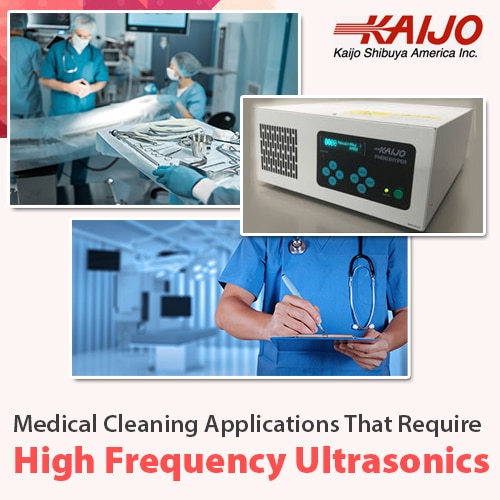Medical Cleaning Applications That Require High Frequency Ultrasonics
June 23, 2022
 When high-tech medical devices and instruments such as implants, probes, and surgical tools have to be cleaned and sterilized before use, traditional autoclave methods often can’t be used. The high temperature of steam cleaning and the moisture of an autoclave can damage delicate coatings and electronics. Ultrasonic cleaning at room temperatures in disinfectant baths delivers effective cleaning, however, higher frequency ultrasonics need to be used to avoid damaging fragile medical parts.
When high-tech medical devices and instruments such as implants, probes, and surgical tools have to be cleaned and sterilized before use, traditional autoclave methods often can’t be used. The high temperature of steam cleaning and the moisture of an autoclave can damage delicate coatings and electronics. Ultrasonic cleaning at room temperatures in disinfectant baths delivers effective cleaning, however, higher frequency ultrasonics need to be used to avoid damaging fragile medical parts.
Medical ultrasonic cleaning applications will usually use high-frequency ultrasonics for many of their medical instruments and devices. An experienced manufacturer of medical ultrasonic cleaners would recommend the right frequency for cleaning specific types of medical devices. High-frequency ultrasonic cleaning systems using a disinfectant in the cleaning tank can clean and sterilize medical devices safely without damage.
How the Ultrasonic Frequency Affects Cleaning Performance
Ultrasonic cleaning systems work by generating microscopic cavitation bubbles in the cleaning solution. When the bubbles burst, they release powerful jets of liquid that dislodge contaminants from part surfaces. Low ultrasonic frequencies produce comparatively large bubbles and jets strong enough to damage parts and fragile structures. High frequencies produce smaller bubbles and less energetic jets. Adjusting the frequency can ensure the cleaning intensity of the ultrasonic cleaning system avoids damaging delicate parts. The highest ultrasonic frequencies can clean even soft surfaces and fragile microscopic structures without pitting or breakage.
Selecting the Right High Ultrasonic Frequency Depends on Medical Device Characteristics
Complex medical instruments may contain electronics with sensors and optical elements that are easily damaged. Such instruments can be made up of several different types of materials that have varying degrees of resistance to pitting or physical damage. Choosing the right frequency to deliver adequate cleaning while keeping the instruments intact can be challenging. Some devices may require more than one frequency to be cleaned adequately.
Some medical devices are fairly robust but contain microscopic structures that are difficult to clean and easily damaged. Using ultrasonic frequencies above 78 kHz are appropriate for cleaning such parts. The smaller, less energetic cavitation bubbles clean around tiny structural elements and the relatively weak jets of cleaning solution wash away contaminants without causing any damage.
Sometimes a part may seem robust and strong enough to be cleaned at lower ultrasonic frequencies, but it may contain materials that might be damaged. For example, an artificial knee joint made of chromium and titanium may have plastic in between the metal sections. The chromium and titanium surfaces are very hard and resistant to pitting but the plastic parts may sustain damage at frequencies that are too low.
Medical parts may become contaminated with submicron particles that, although very small, still have to be removed. Microscopic contaminants can still be toxic and might cause infection. Such particles are often hard to remove because they are attracted to part surfaces and the surface may have structures that trap such particles. Ultrasonic cleaning with high frequencies acts wherever the cleaning solution can penetrate, and the microscopic jets reach into surface structures to remove even the smallest particles.
Ultrasonic Systems Using the Right High Frequency Can Completely Clean Medical Devices
While high-frequency ultrasonic systems can clean fragile medical devices quickly and completely, choosing the right frequency is important. When the frequency is correctly matched to the medical ultrasonic cleaning application, the ultrasonic systems deliver excellent cleaning performance without the pitting of part surfaces or mechanical damage to delicate structures.
Kaijo’s Knowledge and Experience in Ultrasonic Cleaning
With extensive experience in ultrasonic cleaning technology, Kaijo can recommend medical ultrasonic cleaning systems for specific customer applications. Kaijo provides expert guidance to customers in choosing the right systems and frequencies for their cleaning application without damaging parts. Once the ultrasonic system is installed, Kaijo will ensure the medical cleaning performance meets the needs of each customer.





